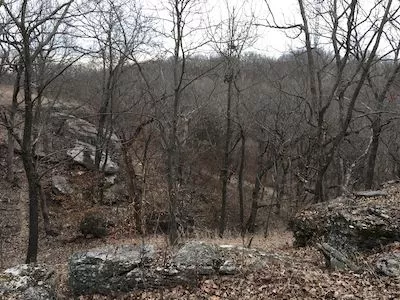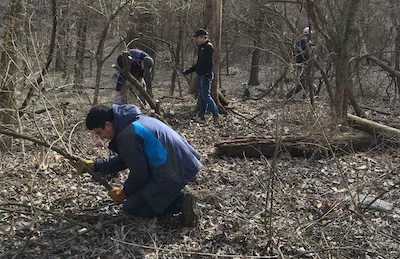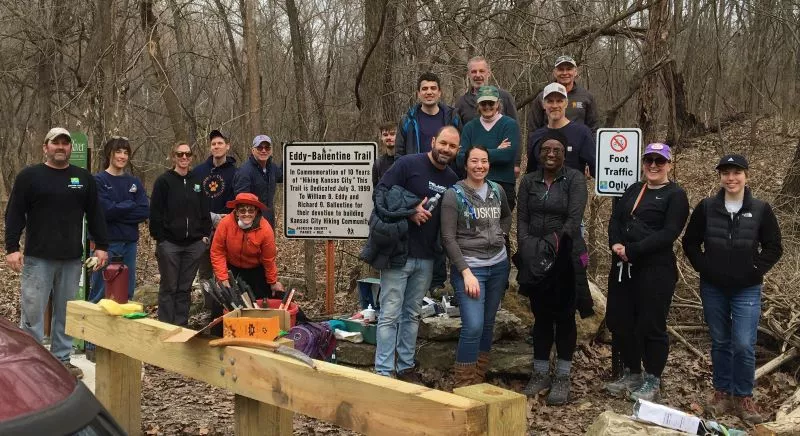Teamwork Helps Restore Eddy-Ballentine Trail Area At the Blue River Parkway
For the past three years the local KC-area Sierra Club group has been working with Jackson County Parks + Rec to restore and improve the Eddy-Ballentine trail area at the County’s Blue River Parkway (south of Lakeside Nature Center and Swope Park).
The volunteer turnout has been very impressive, and an amazing amount of work has been done so far to clear out invasive honeysuckle that had crowded out native plants.
According to Vicky Diaz-Camacho in Flatland, the Kansas City Area is “one of the only places in the world where a ‘Bethany Falls’ limestone layer protrudes from the earth.” Libby Hanssen said in a KCUR story from 2021, “this ‘Bethany Falls’ limestone is part of a rock shelf about 15-30 feet thick that extends for hundreds of miles, shaping the landscape and ecology.”
|
Much of this beautifully weathered and impressive limestone can be seen from the nearby Blue River Glades Natural Area, which is accessible from the Eddy-Ballentine Trail, starting at Blue River Road. It's a steep climb up the bluff to the Blue River Glades area, but it is worth it to see the limestone formations and the native plants that grow in the Glade. There are 200- to 300-year-old chinkapin oaks and “a showy display of wildflowers” according to the Missouri Department of Conservation's website, along with “a number of songbirds such as indigo bunting, great-crested flycatcher, yellow-billed cuckoo and the summer tanager.” The Eddy-Ballentine Trail, which makes a 1.4-mile loop at the foot of the bluff, had become overgrown with non-native plants, especially with invasive bush honeysuckle. If the honeysuckle were cleared out, this natural area could provide amazing views and a restful getaway, especially from the stress of city life. |

The Blue River Glades Natural Area rises above the Eddy-Ballentine Trail and features limestone outcrops, 200- to 300-year-old chinkapin oak trees, and native wildflowers in season. The Blue River Glades Trail is a bit more strenuous than the Eddy-Ballentine Trail, but rewards visitors with spectacular views and a special respite from noisy city life. Photo by Ellen Brenneman |
Volunteers Answer the Call
In 2020, local Sierra Club Thomas Hart Benton Group Outings Chair Eileen McManus was thinking about ways to help further the National Sierra Club's “Outdoors for All” and “Nearby Nature” programs. These programs seek to help city dwellers and marginalized groups, especially youth, enjoy better access to nature and the health benefits such access provides. According to the National Sierra Club, “Communities that have been historically underrepresented in the environmental movement are often the same communities that experience limited access to nature and face the greatest economic, social, and personal insecurity today. Nearly two-thirds of the US population does not have close-to-home access to nature, with the greatest disparities found in low-income neighborhoods and communities of color.”
“The Nearby Nature initiative supports local campaigns to advance equitable access to the outdoors at the state and local level,” continues the Sierra Club's Nearby Nature program description. “Projects are shaped in partnership with the local community and may include trail restoration, planting trees and gardens, cleaning up public parks to increase access to nearby nature, or hosting educational community outings.”
|
The Eddy-Ballentine trail area provided an excellent opportunity for volunteers in the KC area to work together on these goals, since it is in a large park already enjoyed by diverse communities. By improving the area, not only could more people enjoy the relatively easy 1.4-mile Eddy-Ballentine loop without having to plan an all-day trip, but also native plants could have a chance to reestablish themselves. Longtime nature lovers are very familiar with the problems caused by invasive honeysuckle, but for a quick refresher, it produces leaves very early before almost anything else and therefore shades out other plants before they get a chance to sprout. Before long it takes over and perpetuates itself very easily because its berries are attractive to birds, which help spread it even further. Please see the USDA web page on bush honeysuckle for a more in-depth explanation of the associated challenges. |

Chris Simpson, who is training to be a Sierra Club Outings Leader, helps get rid of invasive honeysuckle at a February trail-maintenance day. Sierra Club offers scholarships to our popular Backpacking and Wilderness Navigation classes for those in their 20's and 30's if they attend all classes and come to at least one trail-maintenance day. Photo by Ellen Brenneman |
According to the Missouri Department of Conservation, “Because bush honeysuckles form a thick understory, they limit how much sunlight reaches the seedlings of native plants and thus inhibit the growth of new plants. They also compete with native plants for moisture and nutrients in the soil.” If you've ever been on a trail-maintenance outing in our area, or even just walked along the Trolley Trail, you've no doubt seen how it forms a thick barrier and takes over.
First-time volunteers may be reluctant to poke around in the undergrowth because of fear of the unknown. Also, thick honeysuckle can provide cover for dumping and littering. It all adds up to the loss of what could be an inviting, healthy, and restful place to enjoy nature—the kind of place not enough people can access easily.
McManus learned of a Community Conservation Cost-Share program offered by Missouri Department of Conservation and realized it would be a good fit for Sierra Club's “Outdoors for All” and “Nearby Nature” programs. Soon she helped get the ball rolling for Jackson County Parks to apply for Community Conservation funding through this program and begin to ameliorate the Eddy-Ballentine Trail area. Taylor Neff, Community Forester with Missouri Department of Conservation, and staff from the Jackson County Parks + Rec Natural Resources’ Division, were instrumental in writing the proposal and securing the funding.
The application was accepted, and Sierra Club now partners with Jackson County Parks + Rec and the Department of Conservation on carrying out the work. The Sierra Club's part of the cost-sharing was and is being provided in the form of hours worked.
|
McManus calculates that 600 hours of work will have been carried out by the end of the 2024 season. The work began in December 2021, and occurs each December through April. McManus reports that around 90 individual volunteers have helped so far, including many dedicated repeat volunteers. “Volunteers are from both the Thomas Hart Benton and Kanza groups,” McManus explains. “Jackson County Parks + Rec is incredibly appreciative of the work the volunteers have performed to enhance accessibility for the public to enjoy this unique trail,” said Michele Newman, Director, Jackson County Parks + Rec. “We value our partnership with the Sierra Club and the dedicated volunteers who have made this possible.” |

|
What's ahead?
According to Derek Reasons of Jackson County Parks + Rec, one of the next steps will be to bring in a forestry mulcher, a machine that cuts and mulches all at once and is made for big projects. So far, workers have been using loppers, handsaws, and chainsaws. Now that the trailhead area is getting substantially cleared and the cost-share has been processed, the contractor will hit a stretch of trail with especially large plants.
The contractor also sprayed a Conservation-approved anti-invasives herbicide along the trail in November, while honeysuckle was the only species still leafed out and most desirable plants were dormant and unaffected. “We expect to see substantial progress in the next two years,” says McManus.
Further, according to Neff, “We’re in suppression mode. It's doubtful we ever eradicate honeysuckle completely, but we can help restore diversity and native plant regeneration with management.” Neff adds that there will hopefully be prescribed fire in the future, as well.
Another thing soon to be restored, hopefully, will be the health and sense of connection to Nature for the community living nearby.
Big thanks to all the volunteers who have participated so far, and especially to Missouri Department of Conservation, Jackson County Parks + Rec, and the Natural Resources staff who bring the tools we use.
We also look forward to partnering with Kansas City Wildlands (a program run by Bridging the Gap) in the future. We hope we'll soon see you at a trail maintenance day or two—and then on one of the short 30-minute hikes afterwards!